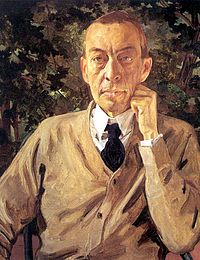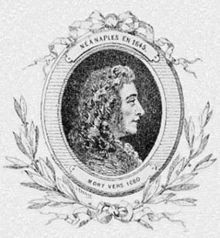April 7, 2014.Rachmaninov and Stradella.We missed the birthday of Sergei Rachmaninov, and probably by more than one week: according to the new calendar, he was born on April 1st of 1873 - but back then Russia was still using the Julian calendar, so contemporary documents state that Rachmaninov was born on March 20th.As talented as he was anachronistic, he wrote 19th century music well into the 20th.But do we really mind if so much of it was so good?Rachmaninov’s life was divided in two by the October revolution: he left Russia at the end of 1917 for a concert tour and never returned.On November 1, 1918, after a series of concerts in Scandinavia, he and his family boarded a ship to New York.He lived in the United States for the rest of his life (Rachmaninov died in 1943 in his home in Beverly Hills).In this second part of his life, he concretized a lot (he was, after all, one of the greatest pianist of the 20th century) and composed rather little.In 26 years he wrote just five major compositions: Piano Concerto no. 4, Variations on a Theme of Corelli, Rhapsody on a Theme of Paganini for piano and orchestra, Symphony no. 3 and Symphonic Dances.The Russian half of his life was much more productive: three piano concertos, two symphonies and the symphonic poem Isle of the Dead, several operas (none of them very successful, except probably Aleko, which he wrote as a graduation work at the Moscow Conservatory) and a large number of piano pieces.The Piano Concerto no. 3 was written in the summer of 1909 during his stay at the much-loved family estate of Ivanovka (it was lost during the Revolution).One of Rachmaninov’s masterpieces, it’s technically one of the most difficult compositions in the piano repertoire.Rachmaninov brought it to his tour of the United States, and premiered the work in New York on November 28, 1909.Walter Damrosch conducted the New York Symphony orchestra.Several weeks later Rachmaninov played it again, this time with Gustav Mahler conducting.We’ll hear it in the 1955 performance by Emil Gilels, one of the greatest interpreters of this concerto.André Cluytens is conducting Orchestre de la Société des Concerts du Conservatoire.The portrait of Rachmaninov, above, was painted by the Russian artist Konstantin Somov in 1925.
The Italian Baroque composer Alessandro Stradella was born on April 3rd, 1639.The legends surrounding his life are spectacular, even if we cannot vouch for their veracity.He was ofnoble descent, probably a Tuscan.In 1669 he moved to Rome, where Queen Cristina of Sweden became his benefactor (later she would offer patronage to Arcangelo Corelli, Alessandro Scarlatti and many other musicians).He attempted to embezzle money from the Church, had multiple affairs and eventually had to leave Rome.He went to Venice where Doge Alvise Contarini hired him as a music tutor to his mistress, Agnese Van Uffele.Uffele and Stradella fell in love and fled to Turin.Contarini sent two assassins after Stradella; they found and attacked him but Stradella survived.He then fled to Genoa where he continued composing and cuckolding local nobility.He met his end at the hands of yet another pair of assassins, this time craftier ones: they stabbed him to death in the center of Genoa, on Piazza Banchi.Stradella was 42.The murder was never solved but it was rumored that a local nobleman hired the killers.While engaged in all these shenanigans, Stradella also found time to compose music: he wrote almost 300 compositions, operas, oratorios, sonatas and other incidental pieces.His “sonatas” for solo instruments and a small orchestras became precursors of concerto grosso, later perfected by Corelli.Here is one of such sonatas, Sonata di viole.It’s performed by Orchestra Barocca della Civica Scuola di Musica di Milano, Enrico Gatti conducting.
Rachmaninov and Stradella, 2014
April 7, 2014. Rachmaninov and Stradella. We missed the birthday of Sergei Rachmaninov, and probably by more than one week: according to the new calendar, he was born on April 1st of 1873 - but back then Russia was still using the Julian calendar, so contemporary documents state that Rachmaninov was born on March 20th. As talented as he was anachronistic, he wrote 19th century music well into the 20th. But do we really mind if so much of it was so good? Rachmaninov’s life was divided in two by the October revolution: he left Russia at the end of 1917 for a concert tour and never returned. On November 1, 1918, after a series of concerts in Scandinavia, he and his family boarded a ship to New York. He lived in the United States for the rest of his life (Rachmaninov died in 1943 in his home in Beverly Hills). In this second part of his life, he concretized a lot (he was, after all, one of the greatest pianist of the 20th century) and composed rather little. In 26 years he wrote just five major compositions: Piano Concerto no. 4, Variations on a Theme of Corelli, Rhapsody on a Theme of Paganini for piano and orchestra, Symphony no. 3 and Symphonic Dances. The Russian half of his life was much more productive: three piano concertos, two symphonies and the symphonic poem Isle of the Dead, several operas (none of them very successful, except probably Aleko, which he wrote as a graduation work at the Moscow Conservatory) and a large number of piano pieces. The Piano Concerto no. 3 was written in the summer of 1909 during his stay at the much-loved family estate of Ivanovka (it was lost during the Revolution). One of Rachmaninov’s masterpieces, it’s technically one of the most difficult compositions in the piano repertoire. Rachmaninov brought it to his tour of the United States, and premiered the work in New York on November 28, 1909. Walter Damrosch conducted the New York Symphony orchestra. Several weeks later Rachmaninov played it again, this time with Gustav Mahler conducting. We’ll hear it in the 1955 performance by Emil Gilels, one of the greatest interpreters of this concerto. André Cluytens is conducting Orchestre de la Société des Concerts du Conservatoire. The portrait of Rachmaninov, above, was painted by the Russian artist Konstantin Somov in 1925.
contemporary documents state that Rachmaninov was born on March 20th. As talented as he was anachronistic, he wrote 19th century music well into the 20th. But do we really mind if so much of it was so good? Rachmaninov’s life was divided in two by the October revolution: he left Russia at the end of 1917 for a concert tour and never returned. On November 1, 1918, after a series of concerts in Scandinavia, he and his family boarded a ship to New York. He lived in the United States for the rest of his life (Rachmaninov died in 1943 in his home in Beverly Hills). In this second part of his life, he concretized a lot (he was, after all, one of the greatest pianist of the 20th century) and composed rather little. In 26 years he wrote just five major compositions: Piano Concerto no. 4, Variations on a Theme of Corelli, Rhapsody on a Theme of Paganini for piano and orchestra, Symphony no. 3 and Symphonic Dances. The Russian half of his life was much more productive: three piano concertos, two symphonies and the symphonic poem Isle of the Dead, several operas (none of them very successful, except probably Aleko, which he wrote as a graduation work at the Moscow Conservatory) and a large number of piano pieces. The Piano Concerto no. 3 was written in the summer of 1909 during his stay at the much-loved family estate of Ivanovka (it was lost during the Revolution). One of Rachmaninov’s masterpieces, it’s technically one of the most difficult compositions in the piano repertoire. Rachmaninov brought it to his tour of the United States, and premiered the work in New York on November 28, 1909. Walter Damrosch conducted the New York Symphony orchestra. Several weeks later Rachmaninov played it again, this time with Gustav Mahler conducting. We’ll hear it in the 1955 performance by Emil Gilels, one of the greatest interpreters of this concerto. André Cluytens is conducting Orchestre de la Société des Concerts du Conservatoire. The portrait of Rachmaninov, above, was painted by the Russian artist Konstantin Somov in 1925.
The Italian Baroque composer Alessandro Stradella was born on April 3rd, 1639. The legends surrounding his life are spectacular, even if we cannot vouch for their veracity. He was of noble descent, probably a Tuscan. In 1669 he moved to Rome, where Queen Cristina of Sweden became his benefactor (later she would offer patronage to Arcangelo Corelli, Alessandro Scarlatti and many other musicians). He attempted to embezzle money from the Church, had multiple affairs and eventually had to leave Rome. He went to Venice where Doge Alvise Contarini hired him as a music tutor to his mistress, Agnese Van Uffele. Uffele and Stradella fell in love and fled to Turin. Contarini sent two assassins after Stradella; they found and attacked him but Stradella survived. He then fled to Genoa where he continued composing and cuckolding local nobility. He met his end at the hands of yet another pair of assassins, this time craftier ones: they stabbed him to death in the center of Genoa, on Piazza Banchi. Stradella was 42. The murder was never solved but it was rumored that a local nobleman hired the killers. While engaged in all these shenanigans, Stradella also found time to compose music: he wrote almost 300 compositions, operas, oratorios, sonatas and other incidental pieces. His “sonatas” for solo instruments and a small orchestras became precursors of concerto grosso, later perfected by Corelli. Here is one of such sonatas, Sonata di viole. It’s performed by Orchestra Barocca della Civica Scuola di Musica di Milano, Enrico Gatti conducting.
He attempted to embezzle money from the Church, had multiple affairs and eventually had to leave Rome. He went to Venice where Doge Alvise Contarini hired him as a music tutor to his mistress, Agnese Van Uffele. Uffele and Stradella fell in love and fled to Turin. Contarini sent two assassins after Stradella; they found and attacked him but Stradella survived. He then fled to Genoa where he continued composing and cuckolding local nobility. He met his end at the hands of yet another pair of assassins, this time craftier ones: they stabbed him to death in the center of Genoa, on Piazza Banchi. Stradella was 42. The murder was never solved but it was rumored that a local nobleman hired the killers. While engaged in all these shenanigans, Stradella also found time to compose music: he wrote almost 300 compositions, operas, oratorios, sonatas and other incidental pieces. His “sonatas” for solo instruments and a small orchestras became precursors of concerto grosso, later perfected by Corelli. Here is one of such sonatas, Sonata di viole. It’s performed by Orchestra Barocca della Civica Scuola di Musica di Milano, Enrico Gatti conducting.